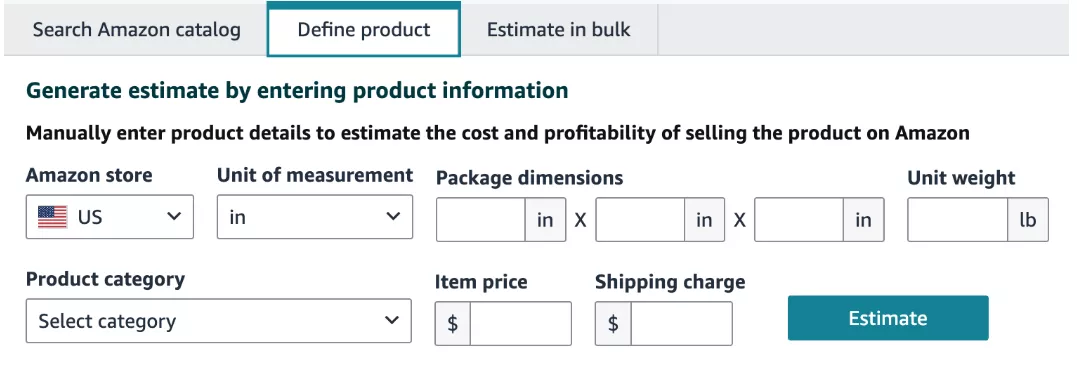Here’s the real deal: Amazon isn’t your friend. The truth is, Amazon selling fees can devour anywhere from 20% to 30% of your product’s selling price — and that's before you even think about advertising, returns or the soul-crushing reality that your competitors are probably selling knockoffs for half the price.
But, millions of sellers still make serious money on Amazon because they understand the fee structure and plan accordingly. This comprehensive guide will break down every Amazon seller fee you’ll come across, from the obvious ones that hit you like a brick wall to the sneaky charges that nibble away at your profits.
The Business Problem: Death by a Thousand Fees
The Amazon seller account fees structure isn't just one fee — it’s a complex web of charges that can include everything from Amazon seller subscription fees to storage costs to advertising spend. Understanding the true fees for selling on Amazon requires looking beyond the obvious charges to include hidden costs like Amazon shipping rates for sellers and currency conversion fees. Many sellers jump into Amazon without understanding the full picture, only to discover their 50% profit margins have mysteriously shrunk to 10% after Amazon takes its cut.
The businesses most affected by these fee structures are typically:
-
New sellers who haven’t factored all costs into their pricing
-
Small to medium-sized businesses with limited cash flow
-
Sellers in competitive niches where price wars are common
-
Anyone selling products over $100 (where Amazon’s percentage-based fees really sting)
These Amazon fees for selling don't just eat into profits — they can determine whether your business survives or becomes another statistic.
Amazon Seller Account Fees: Your Gateway to Financial Enlightenment
Individual Seller Account Fee
If you’re selling fewer than 40 items per month, Amazon offers an Individual plan for $0.99 per item sold. This might seem reasonable for individual sellers just starting out, but you’re essentially paying Amazon a dollar just for the privilege of existing on their platform. The fees to sell on Amazon under this plan include not just the per-item charge but also limited access to customer service and selling tools.
Professional Seller Account Fee
The professional selling plan costs $39.99 per month but waives the per-item fee. This Amazon seller monthly fee is actually a bargain when you consider the benefits.
“100% of Netpeak’s clients use professional seller accounts because the individual selling plan simply isn’t worth it for serious sellers.” — Aliaksandr Vlasenka, Head of Marketplace Growth Department at Netpeak
The Amazon seller membership fee quickly pays for itself once you're moving more than 40 items per month.
Amazon Referral Fees: The Unavoidable Reality
Amazon’s referral fees are their main revenue driver, typically ranging from 8% to 15% depending on your product category. These Amazon commission for selling rates are non-negotiable and apply to every single sale. Books get hit with a 15% fee, while electronics enjoy a more reasonable 8%.
Here’s where it gets interesting: These seller fees on Amazon are charged as a percentage of your total selling price, including shipping and gift wrapping. So if you’re selling a $50 item with $10 shipping, Amazon takes their cut from the full $60.
Fulfillment by Amazon (FBA) Fees: Convenience Comes at a Cost
Fulfillment Fees (Pick, Pack & Ship)
Fulfillment by Amazon (FBA) fees cover the cost of storing, picking, packing and shipping your goods. These fees vary by size and weight, starting around $3 for small items and scaling up for larger products. Why choose FBA? Customers prefer FBA items because of Amazon’s shipping speed. Raise your hand if you’re NOT addicted to two-day shipping. They also trust Amazon’s customer service more than that of a seller they’ve never done business with before.
Monthly Storage Fees
Amazon charges storage fees based on the cubic feet of space your inventory takes up. Standard-size items cost $0.87 per cubic foot from January to September, jumping to $2.40 during Q4 (October to December because of Black Friday, the holidays, etc.). Oversized items come with even steeper rates.
Long-Term Storage Fees
Leave your products in Amazon’s warehouse for more than a year, and you’ll face long-term storage fees of $6.90 per cubic foot. It’s Amazon’s not-so-subtle way of saying “move your products or pay up.”
Removal and Disposal Fees
Getting your products out of Amazon’s warehouse costs money too. Removal fees range from $0.50 to $0.60 per item, while disposal fees run $0.15 to $0.30 per item. Yep, Amazon charges you to throw away your own products.
Return Processing Fees
When customers return items through the FBA program, Amazon charges return processing fees on top of the original fulfillment fee. This is particularly painful for fashion sellers, where nearly 30% of items get returned due to sizing issues. The process to refund a customer involves multiple fee layers that can significantly burn your margins.
Amazon Advertising Costs: Pay to Play
Sponsored Products PPC
Most sellers find advertising essential for visibility, with costs varying drastically by competition and keyword demand. Sponsored Products ads typically generate the best ROI for most sellers.
Sponsored Brands and Display Ads
These premium advertising options offer better brand visibility but come with higher costs and complexity.
Amazon DSP
Amazon’s Demand-Side Platform (DSP) requires a minimum spend of $35,000 per month, making it feasible only for large brands with serious advertising budgets.
Category-Specific & Specialty Fees
Amazon loves to add extra charges for selling on Amazon in specific categories:
-
High-volume listing fees for sellers with massive inventories
-
Dangerous goods fees for products requiring special handling
-
Lithium battery handling fees for electronics
-
Media trade-in program fees for books and electronics
Additional Amazon Fees: The Hidden Costs
Amazon Currency Converter (ACCS) Fees
If you’re selling internationally, currency conversion cuts an additional 3%–10% from your profits.
Multi-Channel Fulfillment (MCF) Fees
Using Amazon’s fulfillment network for non-Amazon orders comes with Amazon shipping costs for sellers that are typically higher than standard FBA rates.
Refund Administration Fees
Amazon charges a refund administration fee of $5 or 20% of the applicable referral fee (whichever is less) when processing customer refunds.
📊 Amazon Seller Fees Overview
|
Fee Type |
Cost |
Applies To |
Learn More |
|
Individual Seller Fee |
$0.99 per item sold |
Sellers with < 40 items/month |
|
|
Professional Seller Fee |
$39.99/month |
All high-volume or serious sellers |
|
|
Referral Fees |
8%–15% of sale price (includes shipping) |
All sellers, varies by category |
|
|
FBA Fulfillment Fees |
~$3+ per item, varies by size/weight |
Sellers using FBA |
|
|
Monthly Storage Fees |
$0.87–$2.40/cu ft (higher in Q4) |
FBA sellers |
|
|
Long-Term Storage Fees |
$6.90/cu ft after 365 days |
FBA sellers with old inventory |
|
|
Removal & Disposal Fees |
$0.25–$0.60 per item |
FBA sellers removing or disposing inventory |
|
|
Return Processing Fees |
Equal to original fulfillment fee |
FBA sellers, mostly in apparel & footwear |
|
|
Amazon Ads (PPC) |
Varies by keyword competitiveness |
Sellers running Sponsored ads |
|
|
DSP Advertising |
$35,000+ minimum spend |
Large brands with advanced targeting needs |
|
|
Currency Conversion Fee |
3%–10% |
International sellers using ACCS |
|
|
Refund Administration Fee |
$5 or 20% of referral fee (whichever less) |
When refunds are issued |
How to Calculate Your Total Selling Costs
Calculating your true Amazon selling fees requires considering:
-
Monthly Amazon seller subscription fee ($39.99 for Professional)
-
Referral fees (8%–15% of sale price)
-
Fulfillment fees (varies by size/weight)
-
Storage fees (monthly charges)
-
Advertising costs (varies by strategy)
-
Return processing fees
-
Currency conversion fees (if applicable)
Industry experts recommend maintaining at least 60% gross margins to stay profitable after all fees. Use tools like Helium 10 or Amazon’s fee calculator for estimates, and remember these will always be estimates because Amazon is always changing.
Tips for Lowering Your Amazon Selling Fees
Optimize your packaging: Reduce dimensional weight with compact packaging. A perfect example is a mattress in a vacuum bag.
Manage inventory timing: Avoid long-term storage fees by monitoring inventory turnover and removing slow-moving products before they hit the 365-day mark.
Price strategically: Factor all fees into your pricing from the start. Many sellers price too low at first, then struggle to raise prices later while maintaining competitive positioning.
Leverage Amazon programs: The Small and Light program offers reduced FBA fees for lightweight, low-priced items under $7.
Monitor your returns: Understand your return rates by category and adjust your product mix accordingly. This is key to understanding your products.
Choose the right selling plan: Professional seller accounts provide better tools and customer service access compared to individual plans.
Understand when to sell on Amazon versus other platforms: Sometimes the higher fees are worth it for the massive customer base and fulfillment by Amazon infrastructure.
2025 Fee Changes and New Seller Benefits
Amazon continues evolving its fee structure, with FBA fees increasing annually. However, new sellers can access bonus programs and incentives. The Small and Light program has expanded, and free returns now cover more categories.
For sellers looking to optimize their Amazon strategy, services like Amazon agency management and Amazon account management can provide expert guidance on navigating these complex fee structures.
The Takeaway?
Understanding Amazon fees for selling isn’t just about knowing what you’ll pay — it’s about building a sustainable business model that accounts for every cost. Yes, Amazon takes a substantial cut, but they also provide access to millions of customers and world-class fulfillment infrastructure.
The key is going in with your eyes wide open, pricing appropriately and optimizing every part of your operations to keep healthy margins. Remember: Amazon is not your buddy, but they can be a profitable business partner if you play by their rules and plan accordingly.
For more insights on succeeding on Amazon, check out our guides on how to start selling on Amazon and Amazon brand positioning strategies.
Want to understand your true Amazon profit potential? Book a strategy call with a Netpeak expert — we’ll break down your costs and show you how to scale profitably.
FAQ
What fees do Amazon sellers pay?
Amazon sellers pay subscription fees, referral fees, fulfillment fees, storage fees, advertising costs and various specialty fees depending on their products and selling strategy.
What percentage of each sale does Amazon take?
Amazon usually takes 20%–30% of each sale when you factor in referral fees, fulfillment fees and other charges.
How to calculate Amazon seller fees?
Use Amazon’s fee calculator or tools like Helium 10 to estimate costs based on your product dimensions, weight, category and selling price.
How to pay Amazon seller fees?
Amazon automatically deducts fees from your sales proceeds. You don’t need to pay them separately.
Is it cheaper to sell on eBay or Amazon?
eBay has lower fees, but Amazon offers more traffic and superior fulfillment options through FBA, often resulting in higher overall profitability despite higher fees.
Related Articles
Segments vs. Audiences in Google Analytics 4: A Comprehensive Setup Guide
You will learn how to correctly set up custom audiences, allowing you to save time and gain insight into your audience
PPC for E-commerce: How to Buy Attention Without Going Broke
Learn how PPC for e-commerce can drive fast sales for your store without draining your budget. Smart strategies, beginner tips, and proven ways to scale profitably.
Personalization 2.0: Breaking the Deadlock of Cold Newsletters
Most leads in managerial positions receive dozens of similar messages every day. Below, I will present the algorithms and techniques that increased our partners' campaign conversion rates from 1% to 11%




